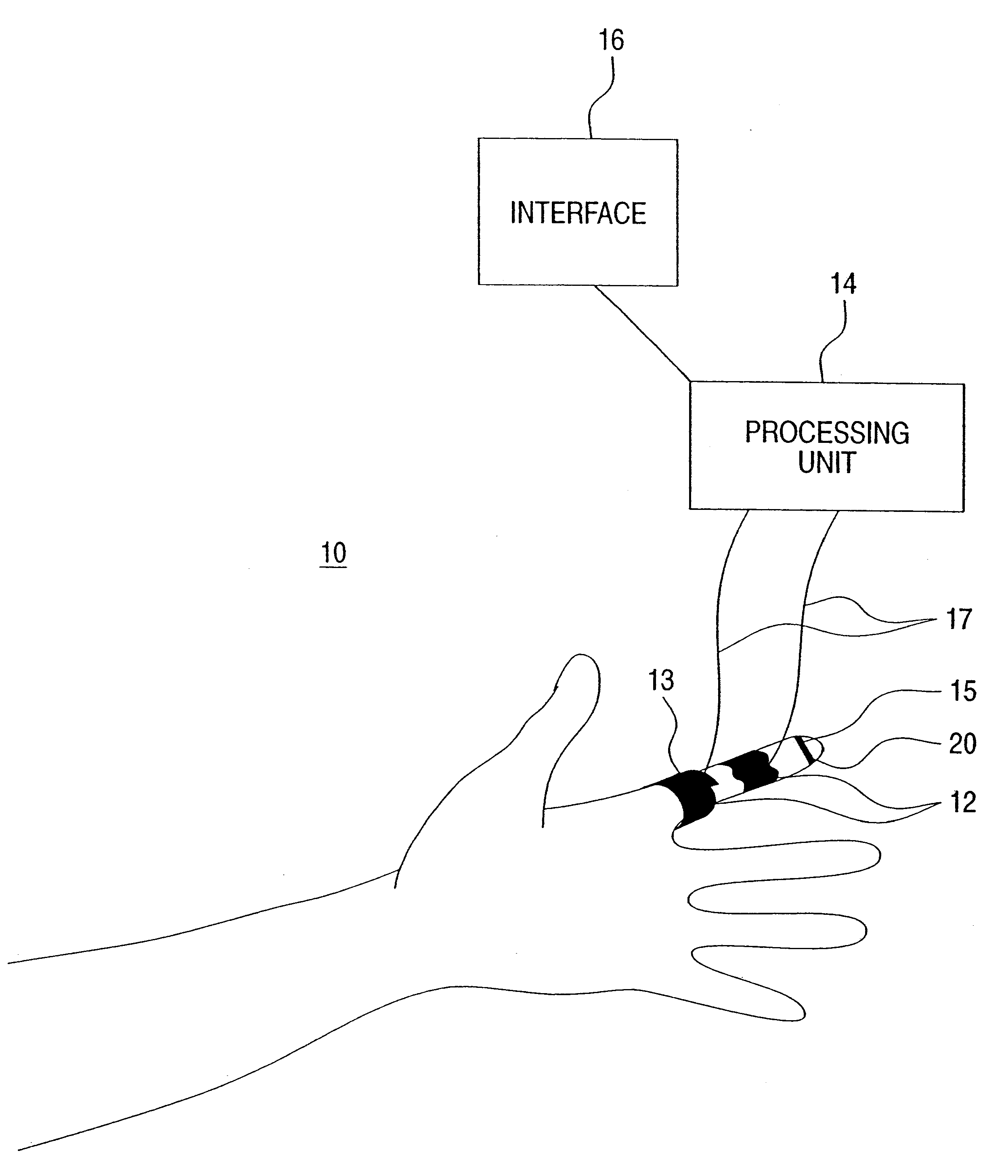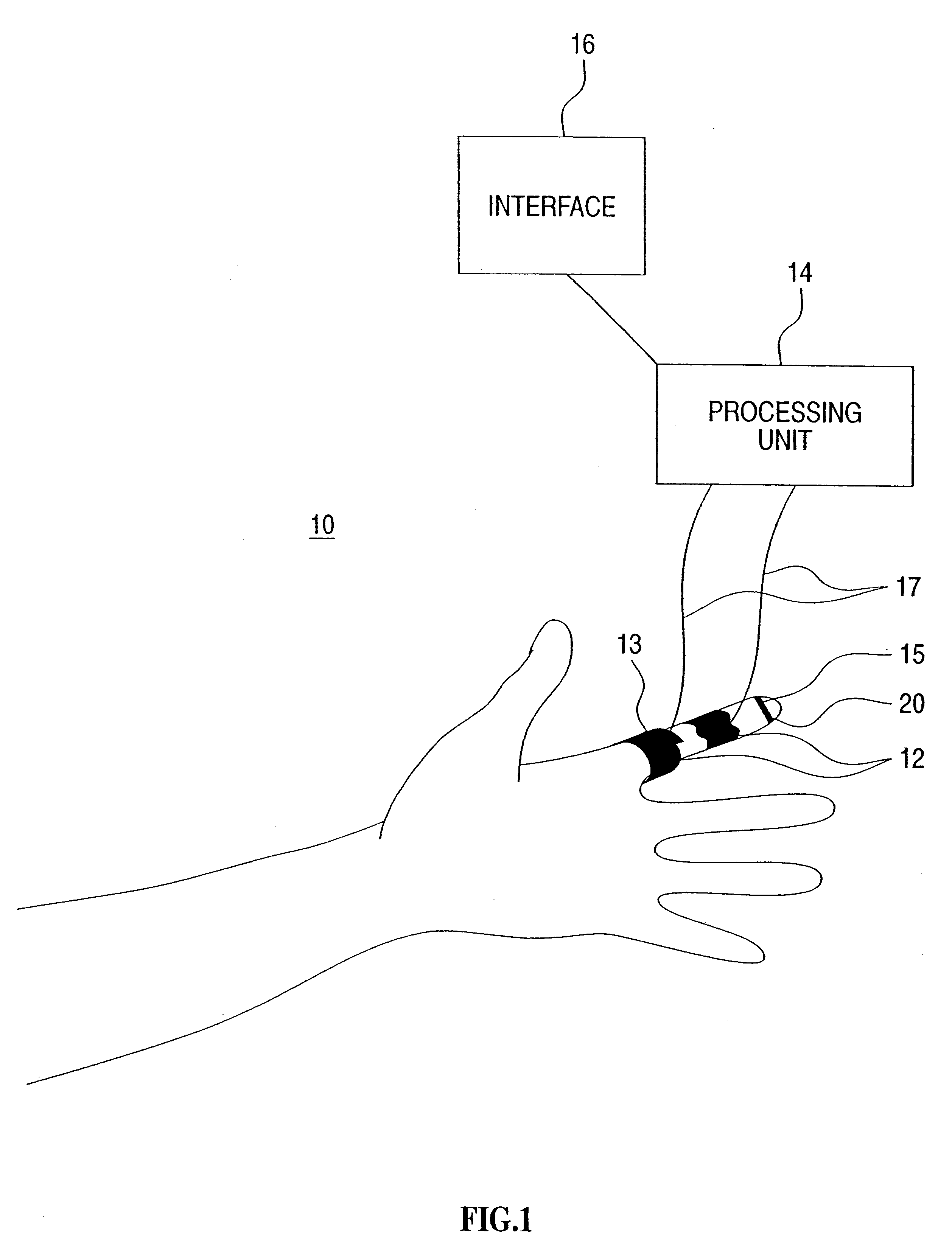System and method for non-invasively monitoring hemodynamic parameters
a hemodynamic parameter and non-invasive technology, applied in the field of systems and methods for non-invasive monitoring of hemodynamic parameters, can solve problems such as immediate blood pressure measurement, tissue damage, and even death, and achieve the effects of preventing future blood pressure from rising
- Summary
- Abstract
- Description
- Claims
- Application Information
AI Technical Summary
Problems solved by technology
Method used
Image
Examples
example 1
General Outline of the Method of the Present Invention
The present invention utilizes two or more photoplethysmograph detectors to collect infrared signal data from blood vessels underlying the skin.
In order to process the signals resultant from the photoplethysmograph detectors (PPG detectors or PPGs) into values useful for determining parameters such as, for example, blood pressure, blood viscosity, blood density, blood vessel radius and blood vessel elasticity, the following general steps are performed.
(i) A low pass filter (.about.250 Hz) is used to remove noise from the signals generated by from the PPG detectors.
(ii) The beginning and end of a heart beat are detected by finding the local minimum points of the PPG signals.
(iii) The signals from each PPG detector are divided into separate segments, each segment being reflective of a single heart beat. Segments from the PPGs corresponding to the same heart beat are co-analyzed.
(iv) A fast Fourier transform (FFT) is performed for e...
example 2
The IRC Method
The following Equations are utilized in order to determine parameters associated with blood flow in a blood vessel according to preferred embodiments of the present invention.
A model of a blood vessel is represented in FIG. 5.
The following Equations describe the amplitude of the blood volume signals (.eta..sub.1, .eta..sub.2) measured by the two PPG detectors, as a function of the forward wave amplitude (A.sub.n).
In all the Equations below n indicates the harmonic number. Each of the Equation is then used for n=1 . . . 6. ##EQU1##
The above pair of Equations can be reduced to a single Equation without the dependence on the forward wave amplitude (A.sub.n): ##EQU2##
Equation 2 can be rearranged in order to reflect the dependence on ##EQU3##
The reflection coefficient can be described by the following Equation (4) assuming that .gamma..sub.n has only a real value: ##EQU4##
Due to the fact that the phase difference between the forward propagated wave on the two detectors is s...
example 3
Results
Calculating R, .beta., C.sub.0 :
Table 1, and FIGS. 8-10 respectively, represent the results obtained for R, .beta., C.sub.0 using the Equations described under Example 2. The values for C.sub.0 were obtained prior to a calibration process and therefor are accurate only within a linear range of C.sub.0. The values for R were calculated while assuming a known value for .nu. (for blood, .nu.=0.0381 cm.sup.2 / sec) and are presented only to show the correlation with vivo measurements.
Calculating a Continuous Blood Pressure:
Calculating a continuous blood pressure requires calculating the systolic and diastolic blood pressure and calculating the waveform of the continuous blood pressure signal.
Calculating the systolic and diastolic blood pressure for each heart beat can be achieved by using the Hill Equation ("cardiovascular fluid dynamics"--Uri Dinnar, CRC Press, 1981) and further by assuming (i) that in a blood vessel there is a linear correlation between stress and strain (.sigma...
PUM
 Login to View More
Login to View More Abstract
Description
Claims
Application Information
 Login to View More
Login to View More - R&D
- Intellectual Property
- Life Sciences
- Materials
- Tech Scout
- Unparalleled Data Quality
- Higher Quality Content
- 60% Fewer Hallucinations
Browse by: Latest US Patents, China's latest patents, Technical Efficacy Thesaurus, Application Domain, Technology Topic, Popular Technical Reports.
© 2025 PatSnap. All rights reserved.Legal|Privacy policy|Modern Slavery Act Transparency Statement|Sitemap|About US| Contact US: help@patsnap.com



